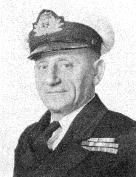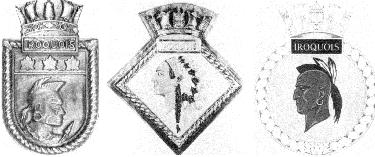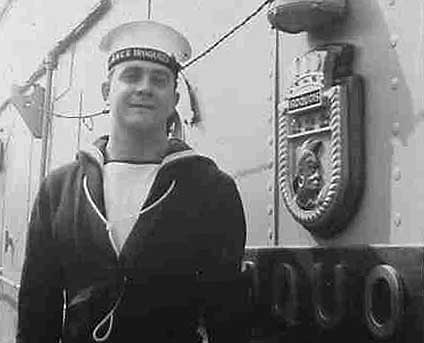A BADGE COMES HOME
From Crowsnest Magazine; Vol 13 No. 4; Feb 1961
- IN THE AFTER CANOPY of the Tribal class destroyer
escort HMCS IROQUOIS there hangs today a large, brass ship's badge, showing
an Indian in feathered headdress and bearing the word "IROQUOIS". It is
a bit of heraldry that dates back to a time long before the present IROQUOIS
came into being and one that, for a time, was a deep mystery. In October
1956 the IROQUOIS called at Londonderry, Northern Ireland, and her commanding
officer, Cdr. D. L. Hanington, was invited to visit the Londonderry Sea
Cadet Corps, which wished to present a hand-carved corps badge to the ship
as a memento of the visit. More especially, they wished to show him a prized
possession - a large, brass IROQUOIS badge.
The badge was well executed, but it was unlike
any known to have been displayed in the IROQUOIS, nor was the Canadian
warship ever known to have presented a copy of her badge to the Sea Cadet
Corps. The commanding officer of the corps, however, felt that it must
have been a gift of Canadian origin, for he had first seen it when the
corps moved into a building formerly used by the RCN as a canteen.
 Photo
of Lt. Bell.
Photo
of Lt. Bell.
More than a generation earlier, "Daisy" Bell had
served as a young sailor in HMS IROQUOIS on the China Station. His vivid
memories of service in the ship spurred in him a determination to see that
the badge came home to her Canadian namesake. The task was to involve Lt.
Bell in a tangle of correspondence and personal expense, but his efforts
met with a Success that was reflected in a ceremony in Portsmouth, England,
on Sunday, October 9, 1960, in which the badge was ceremoniously handed
over to Cdr. H. W. A. Moxley, commanding officer of HMCS IROQUOIS. Lt.
Bell had originally offered to buy the badge and present it to the IROQUOIS,
provided that it would be given to the Maritime Museum of Canada in Halifax,
once the name IROQUOIS was removed from the roster of commissioned ships
in the RCN. But the Sea Cadets would have nothing to do with the sale of
their prized badge. Instead, they proposed to make a gift of it to the
IROQUOIS, under the condition that Lt. Bell had proposed - that it go to
the Maritime Museum once the IROQUOIS was paid off for good.
| Quarterdeck Crest of HMS IROQUOIS
First Commission--China Station Commissioned Devonport, 30 November, 1922 Paid off at Hong Kong, 12 June, 1925 Presented to HMCS IROQUOIS by the Londonderry Sea Cadet Unit (No. 222) as a token of the friendship, esteem and co-operation which exists between the Royal Navy and the Royal Canadian Navy. |
After the ceremony, the cadets were taken in small
groups by their IROQUOIS hosts for a thorough tour of the ship. Then, to
the music of the unit band, the cadets marched past Cdr. Moxley and returned
to their headquarters in the Royal Navy Barracks. "A fine body of boys,"
said Cdr. Moxley. The IROQUOIS welfare committee has since approved a donation
of $50 for the sports fund of the Londonderry cadets.
 |
(Above) Three IROQUOIS badges. The one in the center long prized by Sea Cadets in Londonderry, Northern Ireland who thought it was a gift from a Canadian ship was identified by Lt. W.E.F. Bell of Ottawa as the badge of a survey ship, HMS IROQUOIS in which he served. At the left is the badge worn by HMCS IROQUOIS near the close of WWII; at the right the official ship's badge of today. (L to R: HS-1573-2; CN-3120; O-893-29)
Lt. Bell recalls that the ship which started this sequence of events was converted from one of the double-ender 1917-18 "Q" ships, designed for anti-submarine duty. He questions whether she had a name when she first put to sea, probably being simply "Q number so-and-so." "However, she was pulled out of the reserve in Saltash Creek, Devonport, and refitted as a survey ship for the Royal Navy. She was named HMS IROQUOIS and served on the China Station, relieving the old HMS Merlin, which was just about ready to come apart at the seams." He made some notes on the ship's first commission on the back page of his photograph album, which show that she was commissioned at Devonport on November 30, 1922, sailed from there on December 8 and arrived at Hong Kong on May 2, 1923. She spent her commission in survey duties off the Malay States and in South China seas, including the original survey for the Singapore naval base and dockyard. She was paid off at Hong Kong on June 12, 1925.
That may explain why the badge finished up in Derry," he said. Lt. Bell has described the thrill he received when he learned that the badge of his old ship had come to light. "Believe me," he wrote to Cdr. Hanington, "the description of the badge in The Crowsnest literally leaped out of the page at me. It was a beautiful badge and we were proud of it in its uniqueness in the RN and proud of our ship. She was a hard-working ship, with a hard-working crew; surveying at sea and in the jungle was tough, even if it was only 35 years ago. "You may be sure that we of the first IROQUOIS never imagined what the second IROQUOIS would be like. Nevertheless, you may be proud of the fact that the first of the name worked hard in a job which contributed much to the safety of all the ships which followed her in those far off waters-even if Admiral Levison did send us a signal on entering harbour on one occasion, to the effect that we looked like a Chinese laundry under weigh."
 |
In a rare photo taken in May 1957, Leading Seaman
Lawrence Redman stands next to a badge of Iroquois described in the story
above. Today, the official badge of the ship has the Iroquois brave facing
left. (Photo provided by Lawrence Redman . It was not part of the original
story.)
|
|